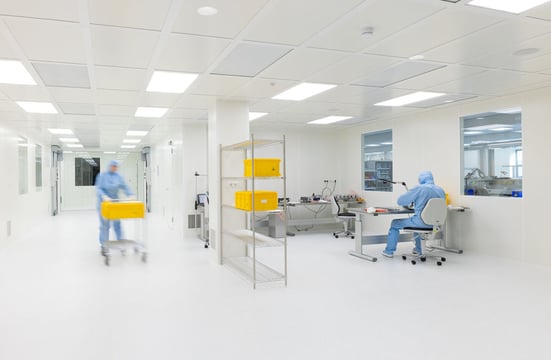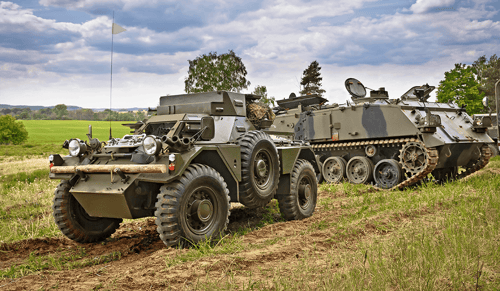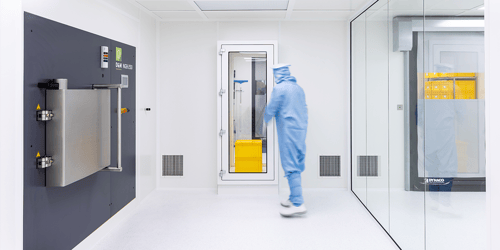How sensors perform reliably in vacuum applications

In many high-tech applications, ordinary air is more of a hindrance than a help. In the semiconductor industry, precision instrumentation and lab automation, work is therefore carried out in vacuum environments, where there are almost no air particles. This prevents contamination and disruption, but also places extreme demands on components such as sensors, which are required to operate there. In this blog, we dive into the world of vacuum sensors: What makes their operation in such an environment so challenging, and what solutions are there?
In a normal environment, the atmospheric pressure is typically about 1,000 millibars (or 100 kilopascals). This is the reading you get on a barometer used to predict the weather. Many (high-tech) applications require a specially conditioned vacuum environment in which to operate. Consider the semiconductor industry in which the EUV light used is absorbed by air. Or high-precision position measurements for which disturbances caused by air currents and turbulence must be kept to an absolute minimum.
Airborne dust particles and molecules can be a contaminating and even obstructive factor in such applications, which can render the process impossible, especially when they start to accumulate.
There are many degrees between atmospheric pressure and the perfect vacuum of 0 Pa, which is only theoretically achievable. Whether it concerns the semiconductor industry, (medical) instruments, lab automation or nanomaterials, each application area has its own specific requirements for the level of vacuum pressure, the level of contamination permissible and which molecules are most critical. For specialists in vacuum technology, it is very common to work with vacuum environments down to around 3 Pa.
An environment with such a low air pressure is not easy to achieve and therefore places high demands on all objects and materials you want to place in such a vacuum chamber. This also applies to the sensors you wish to use. And these are almost always needed. Consider a pressure sensor to determine the actual level of the vacuum in the chamber, a temperature sensor, distance measurements to monitor the process or encoders to regulate movement in the vacuum. In this blog, we discuss the challenges and solutions and show what options are available.
Sensors in vacuum environments: challenges and solutions
Measuring in vacuum environments presents unique challenges. Materials can outgas, heat has nowhere to go, and not every component can withstand vacuum conditions. Yet sensors must continue to perform reliably under these conditions. What challenges and solutions do you encounter with sensors in vacuum environments?
Outgassing
One of the major challenges is that all materials 'outgas' in a vacuum. Through evaporation or sublimation, they release small amounts of gas in a vacuum environment that cannot be (completely) removed using a vacuum pump and thus contaminate the vacuum chamber. This is easy to imagine in the case of contaminants such as residual moisture, sealant or lubricant, or if the wrong adhesives and epoxies are used. But a lot of hard materials such as metals or glass also emit small amounts of gas in a vacuum.
The first obvious step is to choose sensors and materials that minimize outgassing, for example because they can be properly pretreated. Good selection is essential. It helps for sensor heads to be enclosed in ceramic, for example. And for potting, for example, Tra-Con Bipax is a commonly used material. Potting is used for finishing components and for filling empty spaces in a system that would otherwise be difficult to evacuate.
The second step in minimizing outgassing is to clean all components extremely well before they enter the vacuum. This is because the less contamination introduced, the higher the achievable vacuum level becomes. This requires a carefully designed production process and, of course, thorough cleaning with the appropriate cleaning products. But it goes beyond that. The construction of a system is also important. Deep corners or a profile on a part may be convenient in production or aesthetically interesting, but these are places where contaminations can accumulate. So always think carefully about how essential and functional design choices are because they can affect a vacuum environment.
Bake-out oven
Ultra cleanliness is of course achieved by properly pretreating all components before they enter the vacuum chamber. One way to do this is for the outgassing process to take place beforehand in a so-called bake-out oven. The heat vaporizes and sublimates all the 'loose' particles so they are no longer a factor when that component or module is later placed in a vacuum. At Sentech, we have a bake-out oven for the ultra-clean delivery of our sensor modules.
How long and at what temperature a component must be placed in the bake-out oven depends on how high the requirements are for the vacuum for which it is intended. There are limits to how high the temperature can be raised, however. All sensors have a maximum temperature they can withstand. And because the process also becomes more expensive if the oven is on longer or at a higher temperature, the key is to always find the right balance.
A production process should be checked on a spot-check basis. This is done using residual gas analysis (RGA). To ensure the integrity of this procedure, we have the checks performed externally by a qualified party. These kinds of checks are needed throughout the chain. After all, if it turns out afterward that a mistake was made somewhere and the level of contamination is too high, it can be very complex to find out the root cause. By continuously monitoring and validating, we can catch any problems at an early stage.

Bake-out is the process of heating materials to remove gases, moisture, solvents, and other contaminants.
Temperature and cooling
A vacuum has the disadvantage that there is literally nothing to dissipate any heat from the process or from the (electronic) components. Cooling by air convection is therefore not an option. This means you must think carefully about temperature management. As a system heats up, temperature drift can adversely affect a sensor measurement; heat build-up comes at the expense of accuracy. You should therefore choose sensors with low energy consumption to minimize heat build-up. Because once again the cliché applies: prevention is better than cure.
If it is really necessary and the design allows for it, there is the option to include active cooling. For example, by dissipating heat through water pipes. Such a solution does make a design more complex, however.
Vacuum-resistant components
It may be obvious, but all components, electronic parts and sensors used in a vacuum chamber must be able to withstand a vacuum. Communication and experience are incredibly important here because vacuum resistance is a characteristic that is generally not included in a spec sheet. As a module builder or system supplier, you have to stay in constant dialogue with both manufacturers and clients. It is a chain responsibility. And because it is also a field that continues to evolve, everyone learns from each other and suppliers, specialists and end users raise vacuum development to a higher level as partners.
Signal transmission
The measurement signal from a sensor must be processed. Especially with accurate measurements, it is important that processing is also accurate. It is wise to place the processing unit outside the vacuum chamber because the required electronics generate more heat than is desirable in that environment, as well as taking up valuable space.
There are a lot of so-called feed-through solutions available that can provide signal transmission from inside to outside the vacuum chamber. It does not matter which sensor technology is chosen - optical, inductive, capacitive. Of course, it is again important to select cables suitable for use in a vacuum.
7 tips for sensors in a vacuum
- Choose materials that are easy to clean and minimize outgassing;
- Adjust the construction so that there are no hidden corners and cavities;
- Use low-power components because heat dissipation is challenging;
- Place signal processing equipment outside the vacuum chamber;
- Make use of suitable cabling for the transition from vacuum to atmospheric environment;
- Test modules under realistic conditions so that there are no surprises at the end;
- Work with a vacuum integration specialist; together you will know more.
Help with your sensor integration
If you are an engineer who works with applications in vacuum environments, you know how complex it can be to get sensors to perform reliably. Materials, heat management and signal transmission require specialized knowledge and experience. Our sensor experts have years of experience with sensor solutions in vacuums and know exactly what to look out for.
Want to discuss sensor integration in your vacuum application? Please fill out the contact form and we will get back to you as soon as possible.




